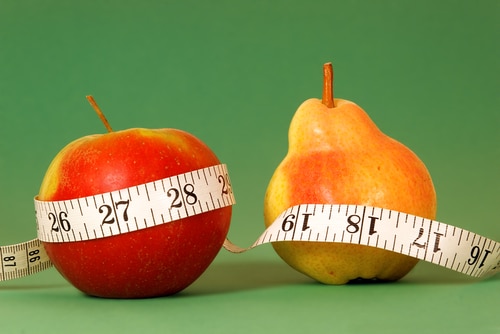
Body Shape and Health
For health purposes, you have one of two body shapes. You’re either pear or apple-shaped. If you take a close look at a pear, you can see it has a narrow top and swells in size as it approaches its base. People with a pear shape have a similar appearance. They have a relatively slender upper body, a defined waistline and carry most of their weight in their hips, buttocks, and thighs. Being pear-shaped makes it more challenging to fit into a pair of skinny shorts, but it’s a benefit from a health standpoint. People with pear shapes who store most of their fat in their lower body have a lower risk of heart disease and type 2 diabetes compared to “apples.”
Unlike pears, apple-shaped people carry their weight in their tummy and waist. They may be blessed with slender thighs, but their mid-section is full because they store more fat there. People with an apple shape are more likely to have metabolic syndrome, a constellation of metabolic problems including high triglyceride levels and high blood pressure that increase the risk for heart disease and type 2 diabetes. This is true regardless of their body weight or BMI. Even people who are of normal body weight may have a greater risk for health problems based on their body shape. That’s because apples have more visceral abdominal fat, the kind that increases the risk of heart disease. An apple shape is essentially a marker for more unhealthy visceral abdominal fat.
How to Determine Whether You’re an Apple or a Pear
Use a tape measure to measure your waistline. Then measure the widest part of your hips. Divide your waist measurement by your hip measurement to get your waist-to-hip ratio. If your waist-to-hip ratio is less than 0.8, you have a pear shape. If it’s greater than 0.8, you’re apple-shaped and may be at higher risk for health problems. For men, the cut-off is 0.9, so men with a ratio greater than 0.9 fall into the danger zone. Some doctors only use waist measurements to determine risk. For women, a waist size of 35 inches falls into the unhealthy zone, while men should be concerned if their waist size is greater than 40 inches.
What to Do if Your Waist Size or Waist-to-Hip Ratio is Unhealthy
If you’re apple shaped, there are things you can do to reduce the amount of visceral fat you have and lower your risk for health problems. One of the best ways to do this is to change your diet. Eliminate processed carbs and carbohydrates from “white” foods such as potatoes, white rice, and pasta, and replace them with fiber-rich carb sources like those in fruits, vegetables, and whole grains. Researchers at the Wake Forest Baptist Medical Center found that every 10-gram increase in soluble fiber reduced unhealthy visceral fat by 3.7%. Replace some of the carbs in your diet with lean protein to help stabilize insulin levels.
Regular exercise, especially high-intensity exercise, also helps to lower visceral abdominal fat. If you already work out and are still carrying too much fat around the waist, add high-intensity intervals to your workout. Research shows high-intensity exercise is better than lower intensity exercise such as walking for reducing abdominal fat of all types.
Finally, make sure you’re not skimping on sleep or getting too much of it. Research shows that short sleep durations of 5 hours or less and long sleep durations of 8 hours or more are both linked with weight gain and increases in visceral fat. Around seven hours a night appears to be optimal for most people.
The Bottom Line?
Your body shape says a lot about your risk for future health problems. Know your waist-to-hip ratio and whether you’re a pear or an apple. If you’re an apple, take steps to lower your risk for future health problems.
References:
Med Sci Sports Exerc. 2008 Nov;40(11):1863-72.
Sleep. 2010 March 1; 33(3): 289-295.

